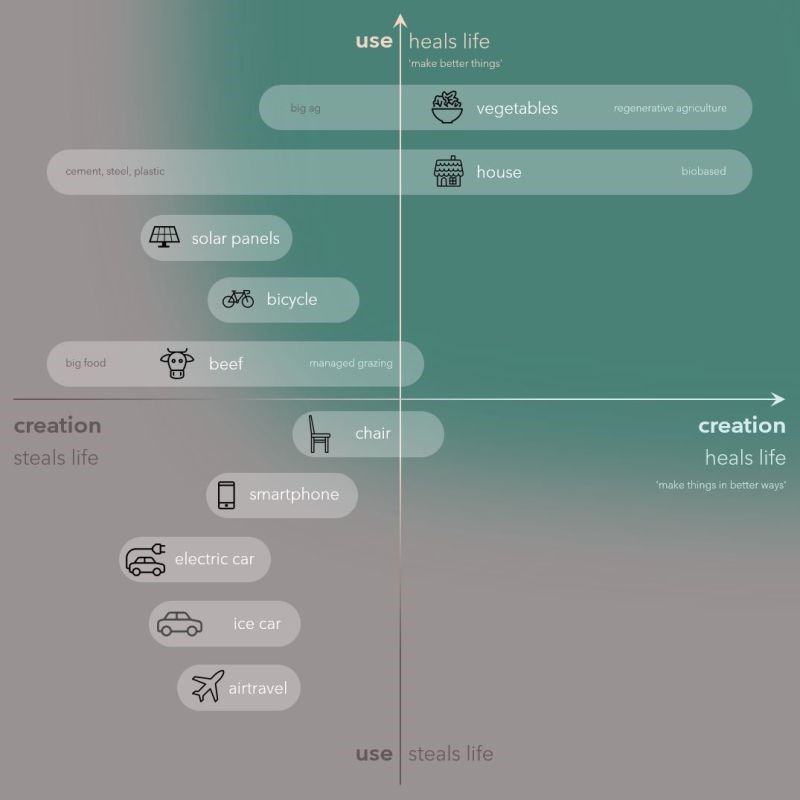REGENERATIVE INTELLIGENCE – THREE MODELS
October 17, 2023
In my search for Regenerative Intelligence, I’m looking for examples and innovative thinking to shift us from degenerative to regenerative. Even from the sustainable idea of “Doing no harm” to life-affirming concept of “Doing more good”. I’ve learned a lot from the people, articles and papers I’ve encountered so far. In this blog, I want to keep it short; three models that can be helpful and inspiring. The first one helps when considering “Is this product regenerative?”. The second model is to assess the regenerative capability of a community or product, while the third is aimed at distinguishing sustainable, circular, and regenerative business models.
1) A Model For Pragmatists: When is a product regenerative?
A very simple model, not meant as a perfect reflection of reality, but more as a conversation starter: “When is a product Regenerative? It was created by Michiel Cornelissen, a Climate Solutions Specialist and designer who is helping companies create net-positive products and strategies.

Read more about this model on Michiel’s LinkedIn. Some takeaways he shared in a post:
“🥗 We would like to be in the top right quadrant, all the time, but that’s predictably difficult. For anything we can make out of nature, there are pathways; if you can grow your vegetables in a system that draws carbon into the soil and creates healthier soil life and such, then you’re creating much more than just veggies. Even if your veggies are from big ag, they’re beneficial, ranking high on the ‘use’ axis.
🏡 Most houses could be called regenerative in function, because of the shelter they provide. *How* we can create them has an enormous range though: From steel and cement they’ll pollute and emit, while a biobased building can sequester carbon.
🚲 Some products, like solar panels or bicycles, are so ‘good for us’, that we should probably accept that producing them will create some emissions and pollution. We should aim for cleaner production, although shifting it to the right side of the line appears nearly impossible. You’d probably need something like ‘regenerative mining’ – whatever that means.
🚗 We tend to think very highly of the electric car’s sustainability, but in fact, it’s a bit worse in production when it comes to things like emissions and pollution. And while you’re driving it, it is still nowhere near regenerative, even if it’s much better than a diesel or gasoline car; it can still kill people and animals and there’s still pollution from tyres and brakes.”
2) A Model for Community builders
This open-source framework offers a 4-stage design process to assess the regenerative capability of current or new projects, or to craft community services and products that benefit both human and ecological systems.
Check out this Regenerative Community Design Canvas by Josine Bakkes

Read more about it here.
3) A model for Definition Lovers: Sustainable, Circular, and Regenerative Business Models
Carbon-neutral, sustainability, circular, regenerative; sometimes you can’t see the forest for the trees. Researchers from the University of Maastricht delved into the literature about these concepts, spoke with six expert groups, and compared papers with each other. The following model emerged, where the dominant system vision, main objectives, and design methods of sustainable, circular, and regenerative business models are presented:
System Vision: In their dominant system vision, sustainable business models primarily focus on socio-technical systems, circular business models on closed economic cycles, and regenerative business models on socio-ecological systems.
Main Objectives: In terms of main objectives, sustainable business models focus on the triple bottom line, circular business models on material productivity, and regenerative business models on the health of the planet and the well-being of society.
Design Methods: Sustainable and circular business models share a design focus on the circular technosphere (designing for the technical cycle and material productivity), sustainable and regenerative business models share a focus on the sustainable ‘human sphere’ (designing to meet human needs within the planet’s boundaries), and circular and regenerative business models share a design focus on the regenerative biosphere (designing for the biological cycle and ecosystem regeneration).
In their paper “Towards Regenerative Business Models: A Necessary Shift?”, the researchers delve deeper into the differences and similarities.

To Conclude
That’s it. Just three models I encountered during my search for Regenerative Intelligence and wanted to share. Let me know if you have any reading tips or ideas about whom I should meet next!
No posts

 English | EN
English | EN 